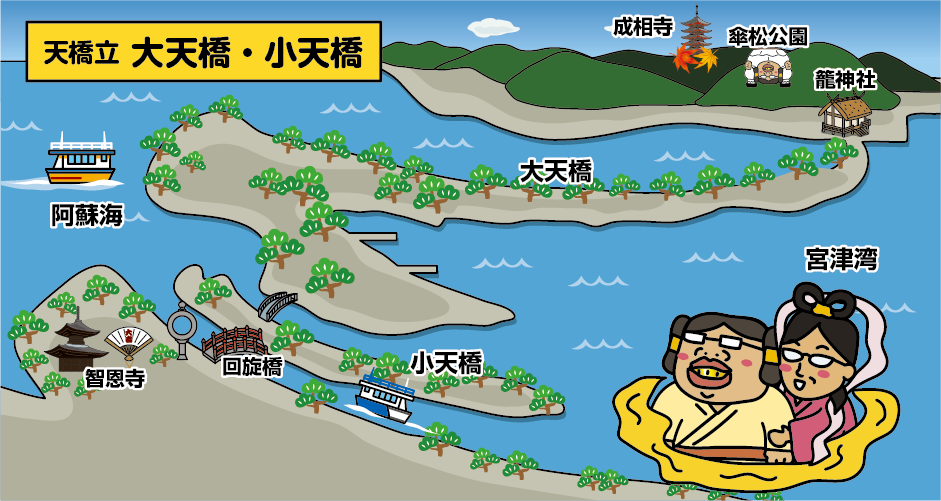Amanohashidate, one of the three most scenic spots in Japan.
What is Amanohashidate like? A summary of the highlights of Amanohashidate!
Amanohashidate is a scenic spot located at the western end of Wakasa Bay, southeast of the Tango Peninsula and Miyazu Bay in northern Kyoto Prefecture and is designated as a Special Place of Scenic Beauty by the Government. Together with Matsushima in Miyagi Prefecture and Miyajima in Hiroshima Prefecture, it is one of the three most scenic spots in Japan. The following illustrations show some of the best places to visit in Amanohashidate. Amanohashidate is a 30-minute drive from the Ine no Funaya.

Amanohashidate is formed by a sandbar (spit) of approximately 2.4 km called “Daitenkyo” and a sandbar (spit) of approximately 0.8 km called “Shotenkyo”. The sandbars, which are approximately 3.2 km long and 20 m to 170 m wide, divide Miyazu Bay and the Aso Sea in two, but the two waters are barely connected by the “Kirido” and “Monju Suido”.

The origin of Amanohashidate can be traced back to the myth of Izanagi and Izanami’s “kuniumi (Land Creation)”, in which the “Amanohashidate” is said to be the “Amanoukihashi (Heavenly Floating Bridge)”. There is also a legend that the ladder used by Izanagi to go back and forth between the heavenly world where gods live and the earthly world where humans live fell overboard while Izanagi was sleeping and became a single long, narrow piece of land, which is why the name Amanohashidate remains.

The view from Mt. Monju, where Amanohashidate Viewland is located on the south side of Amanohashidate, is called “Hiryukan (Flying Dragon View)”, as it looks like a dragon soaring in the sky. The view from the north side, Kasamatsu Park on the hillside of Mt. Nariai, is called “Shoryukan (Ascending Dragon View)”, as it looks like a dragon rising steadily to the right. The view from the east side is called “Sesshukan (Sesshu View)” because it resembles the scenery of Sesshu’s “National Treasure View of Amanohashidate”. The view from the west side is called “Ichijikan (One-Character View)” because it looks like the Chinese character for “ichi (one)”.

Incidentally, Kasamatsu Park is the birthplace of “crotch peeping”, where one stands backwards on the observation platform and looks at Amanohashidate from between one’s legs.

A Japanese university professor who had been researching this “crotch peeping” for more than 10 years proved the “crotch peeping effect”, which is that when you do the “crotch peeping” and invert your upper body, you lose the sense of depth of the landscape and distant objects appear smaller and closer to you than they actually are, and in 2016 was awarded the Ig Nobel Prize for Perception.

The 2.4 km-long sandbar on the Daitenkyo and the rows of some 3,700 pine trees growing there are known as “Hakushaseisho (white sand and green pine trees)”, and passing through the rows of pine trees is one of Amanohashidate’s attractions. Bicycles can be rented at the sightseeing boat ports on both the north and south banks of Amanohashidate, at Amanohashidate Pier in the Monju area to the south and Ichinomiya Pier in the Fuchu area to the north, and can be dropped off in either area. Visitors can enjoy the sightseeing plan of cycling across the pine trees and returning by sightseeing boat.

The bridge over the Monju Suido (Shoutenkyo and Monju area) is a rare bridge that turns 90 degrees each time a large ship passes. Every morning at 9:55 a.m., the bridge turns. On Sundays between 11:00 and 15:00, the bridge turns every hour.

Near the sightseeing boat pier in the Monju area, south of Amanohashidate, there is a uniquely shaped lantern called the ” Chie no Wa (Ring of Wisdom)”. It used to be a nightlight for boats sailing in the area, and legend has it that if you walk through the circle three times, you will “become smarter”. However, if you actually try to pass through the circle, locals will fly in and warn you.

Close to the “Ring of Wisdom”, there is the famous Chion-ji Temple, which is known for the proverb “When three people gather, the wisdom of Monju is greater than the wisdom of the others”. It is one of the three sacred places of worship of Monju Bosatsu (a Buddhist saint who bestows wisdom) in Japan. The temple is visited by worshippers seeking to pass examinations and qualification tests.

The Kono Shrine, located in the Fuchu area on the north side of Amanohashidate, is an old shrine of high prestige, known as “Moto Ise” because legend has it that Amaterasu-okami and Toyouke-no-okami moved from this place to the Ise Jingu Shrine in Mie Prefecture. Amanohashidate has long been regarded as the approach to Kono Shrine.

Nariai-ji Temple is said to have been built around the 8th century as an praying temple by Emperor Monmu. The five-storied pagoda of Nariai-ji Temple is depicted in Sesshu’s “National Treasure View of Amanohashidate”. The current five-storied pagoda is a wooden pagoda completed in 1998. It is also known for its autumn foliage.
Access to Amanohashidate
From Tokyo
It takes about 2 hours and 30 minutes from JR Tokyo Station to JR Kyoto Station by Tokaido Shinkansen.
From Osaka
It takes about 15 minutes by Tokaido Shinkansen from JR Shin-Osaka Station to JR Kyoto Station.
Transfer to the limited express Hashidate at JR Kyoto Station and it takes about 2 hours to Amanohashidate Station on the Kyoto Tango Railway. Alternatively, at JR Kyoto Station, transfer to the JR Sanin Main Line (limited express) to JR Fukuchiyama Station, about 1 hour 30 minutes. At JR Fukuchiyama Station, transfer to the Kyoto Tango Railway Miyafuku Line to Miyazu Station, about 50 minutes. Transfer to the Kyoto Tango Railway Miyatoyo Line at Miyazu Station and it takes about 6 minutes to Amanohashidate Station. Get off at Amanohashidate Station.










You need to login to comment on an article.